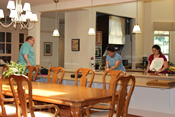Category: McKnight’s Long-Term Care News
Posted by Dr. El - April 3, 2014 - Business Strategies, Common Nursing Home Problems and How Psychologists Can Solve Them, Dementia, McKnight's Long-Term Care News, Role of psychologists

Here’s my latest article on McKnight’s Long-Term Care News:

I watched with dismay as the nurse abruptly moved a table in front of a confused and agitated resident trying to leave the dining room. “Sit down!” she told him in a stern voice. “Dinner will be here in an hour!”
Those of us in long-term care have undoubtedly witnessed similar incidents where residents become agitated and staff members don’t have the tools to prevent or manage their distress. Psychologists — who could offer such tools — are largely limited in the current reimbursement model to providing individual services to cognitively intact residents.
Using mental health expertise
The Eldercare Method, developed by psychologist Kelly O’Shea Carney, PhD, CMC, executive director at the Phoebe Center for Excellence in Dementia Care in Pennsylvania, harnesses the training of mental health professionals to successfully address the gap between what’s known in the mental health world about how to handle challenging behaviors and how they’re often managed in long-term care.
The method uses interdisciplinary teams facilitated by mental health professionals (psychologists and licensed clinical social workers) to examine the causes of resident distress and to identify ways to prevent it. Team members include representatives from the nursing department and other direct care staff such as dietary, housekeeping, and aides.
Needs assessment
The first step in the Eldercare Method is to assess the overall behavioral health needs of the facility and to establish training programs and annual service goals. This dramatically increases the focus on behavioral health as compared to facilities that provide behavioral health training sporadically, often after an incident occurs, missing the opportunity to prevent problems on an ongoing basis.
For the entire article, visit:

Kelly O’Shea Carney, PhD, CMC

Posted by Dr. El - March 20, 2014 - Business Strategies, Customer service, Inspiration, McKnight's Long-Term Care News, Resident care, Something Good About Nursing Homes

Here’s my latest article on McKnight’s Long-Term Care News:

In my last post, I discussed culture change and its positive impact on the mental health of the residents, particularly at Eden Alternative facilities. I recently also had the opportunity to tour a Green House, which I’d heard about but had never seen. While Eden Alternative homes change the culture of care within existing facilities, The Green House Project creates the “ideal” setting from the ground up.
The template of a Green House is a small building that is home to 10 to 12 residents, or “elders,” and two caregiving “Shahbaz,” which is the plural of Shahbazim. A Shahbazim is an aide trained to do almost everything that needs to be done within the house – providing care for the elders, laundering the clothes and bedding, performing light housekeeping, planning meals, cooking, serving the food, engaging the elders in activities, etc.
The house itself is designed to be more like a home, with private rooms off a large common area that includes a living room, dining area and kitchen.
I found this model turned everything I’d known about nursing homes upside down.
Green Hill visit
The first thing I noticed when I pulled up to Green Hill in West Orange, NJ, aside from the impressive entrance to this former hotel, was that there were parking spots reserved for visitors. By contrast, most of the nursing homes I’ve encountered have reserved spaces for upper level staff. This easily replicable idea offers a person-centered approach even before guests enter the facility.
Green Hill has four Green Houses in addition to its other levels of care. Ten elders reside in each of these small buildings in the back of the campus.
Walking into the Green House was very much like entering someone’s home. As I came through the entryway, there was a small, bright room on my left where I later interviewed one of the elders. On my right was a large, open kitchen. A computer monitor was discreetly tucked in the corner next to a glass cake stand holding a freshly baked cake.
For the entire article, visit:
For more on The Green House Project, visit their website.

Green Hill dining area and kitchen
Posted by Dr. El - March 6, 2014 - Business Strategies, Depression/Mental illness/Substance Abuse, McKnight's Long-Term Care News, Resident care

Here’s my latest article on McKnight’s Long-Term Care News:

I was speaking about leadership to a group of administrators recently when the discussion turned to person-centered care. “Culture change, the Eden Alternative, whatever you call it,” I said, “things are moving in that direction. MDS 3.0 has the team asking residents questions that staff members would have answered in the past, such as whether or not residents feel depressed.”
We talked about the impact of this and I continued, “In my experience, the nursing home I worked in that was most attentive to the psychosocial needs of the residents was the one that was in the process of becoming an Eden Alternative home.”
I’m not in any way affiliated with the culture change movement, but I certainly noticed the difference in the atmosphere in the Eden facility and its impact on the residents’ mental health. In traditional facilities, an enormous amount of the residents’ psychotherapy time is devoted to addressing how to work in or around the nursing home system if possible, and how to maintain their equanimity and sense of humor if not. This was less of a focus for residents in the Eden home.
When I work with the staff in a traditional nursing home, I’m often an emissary of the residents, delivering their messages in a way that can be heard by the staff. In the Eden facility, there are more emissaries and more people listening to what the residents have to say in the first place. Being heard is essential for good mental health.
For the entire article, visit:

Posted by Dr. El - February 20, 2014 - Business Strategies, McKnight's Long-Term Care News

Here’s my latest article on McKnight’s Long-Term Care News:

Mr. Cooper was staring out the window when I came by to see him for his weekly psychotherapy session. “There’s no one here to talk to except you,” he said despondently.
“You’re the fourth resident who told me that this week, Mr. Cooper!” I replied. “We need to get all of you together so you can talk to each other!”
Our strength is community
Many, if not most, of the services offered in the nursing home can be provided through home-based care. What sets nursing homes and other long-term care sites apart is the opportunity for residents to socialize with each other with ease.
The community atmosphere can be one of our most appealing aspects and biggest selling points to potential residents. Savvy facilities will make the most of this through developing and promoting their recreation programs and facilitating connections among residents and their families.
Benefits of social connections
According to Anna Miller in her January 2014 article in the American Psychological Association Monitor, having strong social connections has been “linked with such benefits as a greater pain tolerance, a stronger immune system, and a lower risk of depression and early death … [Loneliness causes] physiological processes to activate that are directly bad for your health.” This suggests we can actually improve the physical health of our residents by increasing their involvement in meaningful social activities.
Creating a stronger sense of community
Here are some suggestions to help develop positive connections between residents in long-term care:
1. Facilitate interactions between residents upon their admission.
As I wrote in The Critical Period, the arrival in LTC is a time when new behaviors — such as attending activities — are easiest to establish. Don’t wait until a resident is in the habit of staying alone in his or her room all day; instead, send a welcoming committee to engage the resident immediately. Find out new residents’ interests and connect them to others in the facility who share their passion for gardening or baseball, for instance.
2. Create opportunities to share secrets.
For the entire article, visit:

Posted by Dr. El - February 7, 2014 - Business Strategies, McKnight's Long-Term Care News, Motivating staff, Psychology Research Translated

Here’s my latest article on McKnight’s Long-Term Care News:

“They keep giving me these new aides and they don’t know what they’re doing,” a disgruntled resident commented during a psychotherapy session.
“You’re not the first person to tell me that,” I replied, looking for a way to acknowledge her experience without criticizing either the facility or the new aides. “You have the honor of training them.”
“Yes, if they’d listen,” she said with an edge in her voice. “But it’s a lot of work.”
The turnover rate in long-term care is a significant problem, with rates ranging from 55% to 75% for nurses and aides and sometimes over 100% for aides alone. Having personally witnessed a great deal of turnover during my years in LTC, I was curious about why the rate is so high and what could be done about it. I turned to the research to find the answers.
Costs of turnover
I was dismayed by a study that suggested that the persistence of turnover over the years might be because nursing homes could save money by treating their staff like a never-ending supply of fast food workers and avoiding investment in training and retention practices.
To my great relief, I found data indicating that there are many costs associated with turnover, including increased hospital readmission rates, high employee replacement costs, loss of productivity, poorer quality of care, a decrease in staff and resident morale, increased work stress, job dissatisfaction, increased accident and absenteeism rates, increased overtime costs, and resident and family dissatisfaction. Aside from the moral reasons to reduce turnover, it’s also worthwhile on a strictly monetary basis. An estimate of the per-worker cost of turnover in the general U.S. economy is about 20% of the worker’s annual compensation amount.
Much of the literature looked at turnover in aides and nurses and while the findings weren’t always consistent between studies, the following factors were associated with job dissatisfaction and workers leaving their employers.
Factors associated with turnover
For the entire article, visit:

Posted by Dr. El - January 22, 2014 - Business Strategies, Communication, McKnight's Long-Term Care News, Motivating staff

Here’s my latest article on McKnight’s Long-Term Care News:

After Ms. Ryan’s psychotherapy session, I stopped at the nursing station and asked the nurse for the name of her aide. The nurse pointed to a uniformed woman right next to me, who turned and asked me with hostility, “How do you know it was me?” Surprised, I responded, “I just wanted to tell you Ms. Ryan was really happy with how you did her hair today. She wanted me to thank you for her.” The aide appeared stunned. The nurse commented, “We usually expect complaints, not compliments.”
If your staff is more prepared for criticism than praise about its work, it’s an especially good time to consider positives of an employee recognition program.
Benefits of employee recognition programs
Studies show that employee engagement, productivity and customer service are about 14% better in companies where recognition occurs, compared to companies without a program that acknowledges their efforts. In addition, companies with an effective recognition program have a 31% lower voluntary turnover rate than those with an ineffective program.
Ineffective programs tend to reward employees for tenure rather than performance. (Apparently those 10-year pins aren’t making the desired impact.) Effective programs offer specific feedback about the actions of workers and make it easy to provide that feedback.
Interestingly, there’s a substantial disconnect between the 80% of senior leaders who believe their employees are being recognized on a monthly basis and the 22% of individual workers who report their peers being acknowledged that frequently.
The Oregon Health Care Association’s Staff Retention Toolkit is an excellent resource for information about different types of Employee Recognition Programs (see page 46 in it). The toolkit notes these additional benefits:
For the entire article, visit:

Posted by Dr. El - January 13, 2014 - McKnight's Long-Term Care News, Personal Reflections, Role of psychologists, Stress/Crisis management

Here’s my latest article on McKnight’s Long-Term Care News:

In my last post, I wrote about some of the many things I do for residents as a long-term care psychologist. The astute reader will note that most of the tasks were accomplished during work hours and within the facility. There’s a reason for that.
When I first started out as a shrink, I worked at the Manhattan Psychiatric Center, a setting similar to many nursing homes in that residents didn’t have access to stores and other amenities. “Next time you’re in the supermarket, will you get me some of that lotion I like?” “Can you buy me a new watch battery?”
The small requests were never-ending and because they were so small, I felt I couldn’t refuse.
And then there were the tasks I volunteered for because I could see the need and I was, you know, a nice person.
The breaking point came after I offered to darn a sweater with a small hole in the front. It was only after I got the sweater home that I discovered the large holes in the back. During the hours of mending — I didn’t want to go back on my word — I realized I had to set some limits on these “extras” or I’d quickly burn myself out on my chosen career.
Establishing limits
Knowing I was in this for the long haul, I created a personal “no errands” policy. The exceptions are endeavors that connect residents to their loved ones, such as obtaining and mailing out holiday cards. (And, I admit, I relish Internet searches for estranged family members.) On the occasions where I’m tempted to do something really special, I soul-search and sometimes consult with an advisor to determine if it’s something I’d do for any of my residents or if I’m going too far for one particular person. It’s important to be fair, especially in the “small-town” LTC environment.
Potential for burnout
For the entire article, visit:

Staying in balance while leaning on each other
Posted by Dr. El - December 12, 2013 - Common Nursing Home Problems and How Psychologists Can Solve Them, Communication, Customer service, McKnight's Long-Term Care News

Here’s my latest article on McKnight’s Long-Term Care News:

“My roommate is driving me crazy with his oxygen machine. I haven’t slept in days.”
“Her husband stays in the room all the time, even when she’s in rehab.”
“She always leaves the window open and I’m freezing!”
These are some of the many complaints about roommates I’ve heard from residents over the years. While some roommate difficulties need to be addressed on a situation-by-situation basis, most conflicts revolve around a few basic issues.
Here’s a handy guide to conflicts and potential resolutions to print out and give to staff members involved in making room assignments.
• Temperature of the room: Have the person who likes it colder or hotter by the window/air conditioner/radiator so they are closest to the source. The temperature in the hallway will moderate the atmosphere around the bed near the door. Give extra blankets to those who like to be warm but have a roommate who likes it cool. Or change rooms so that people who like similar conditions room together.
• Noisy medical equipment: Someone with such needs might do better living with a hearing impaired roommate or a sound sleeper or being moved to a private room if it’s a temporary condition.
• Frequently visiting family members: While visiting hours have been expanded in many facilities, it doesn’t mean they need to take place in a resident’s room, especially if it’s disturbing to others. It may be necessary to distinguish between facility visiting hours and in-room visiting hours and to refer families to alternative locations for visits, such as a lounge. Family members can be directed to wait in common areas if their loved one is not in their room.
• Loud televisions: Setting a time (such as 10 p.m.) to lower the volume on TVs and to turn out lights that aren’t in use will help with sleep hygiene on the floors in general and will reduce conflict between roommates (because it’s “policy” and not personal). Those who want a loud television can use a headset or be moved to a room with a hearing impaired roommate.
For the entire article, visit:

Posted by Dr. El - December 4, 2013 - Business Strategies, Customer service, McKnight's Long-Term Care News

Here’s my latest article on McKnight’s Long-Term Care News:

“I hope Santa brings me a Sony DS,” my 7-year-old told me the other day. I can tell you right now that Santa is not bringing her a video game player, but I didn’t want to tell her that or spill the beans about Santa. So I did what I imagine most parents would do in that situation: I asked her what else she hoped Santa would bring.
There are many benefits of hope, according to an article in October’sAmerican Psychological Association Monitor. Researchers report that, “Hopeful people have a greater sense that life is meaningful.” In addition, “Hope is a strong predictor of positive emotions … and a necessary step on the path to contentment.”
Psychologists differentiate hope from optimism, saying that optimism is a feeling that generally good things will happen, while hope tends to be focused on more specific goals. Researchers state that social connections are an important part of being hopeful, counteracting the feeling of being invisible and alone.
Hope in LTC
So what does this have to do with long-term care? As it turns out, a lot.
The article referred to a 2001 study that examined the level of hopefulness of nearly 800 people aged 64-79. Several years later, 29% of those classified as hopeless had died, compared to 11% of those who were hopeful. Researchers note that hopeful people tend to make better health choices.
If hopeful residents are making better health choices, chances are they’re more likely to comply with medical recommendations and dietary guidelines. They’re more likely to get up and go to rehab, increasing your reimbursement rates. Residents who are hopeful, happy, and satisfied are more likely to refer people to your facility.
Helping residents feel hopeful
Residents often enter our facilities after a demoralizing health problem. They may be cut off from their usual support system and worried or fearful about the future. We can help our residents feel more hopeful by implementing the following ideas:
1. A warm welcome from staff: First impressions really are important. Make sure their initial welcome feels personal and reassuring, reducing their feelings of being invisible and alone. I’ve watched new residents being pushed through the doors in stretchers or wheelchairs. The “pusher,” usually an ambulette driver, consults with the security desk for a room number while the resident is ignored.
Instead, train your staff, especially those at the front desk and those who will greet admissions on the floors, to make eye contact with each new person, smile and say, “Mr. Johnson, welcome to My Better Nursing Home.”
2. A friendly greeting from peers: While staff members can provide important information and reassurance for residents, hearing it from others who have been through the same thing is invaluable. A resident welcoming committee shows newbies that there are people who are happy in your facility, leading them to believe that they can be happy too. Residents also can give the lowdown on things staff can’t say, such as which staff members are grumpy and how to work around them.
For the entire article, visit:

Posted by Dr. El - November 14, 2013 - Business Strategies, Customer service, Engaging with families, McKnight's Long-Term Care News

Here’s my latest article on McKnight’s Long-Term Care News:

As the holiday season draws near, more families will be passing through your doors to visit their loved ones at your facility. Out-of-town relatives will be making annual trips and locals will be taking the children to see Grandma during school breaks. This is an ideal time to provide extra services that showcase your high level of care and make the season more pleasant for families and residents.
You’re the experts when it comes to eldercare – most of the families are going through this for the first time. Show your commitment to customer service by giving families the guidance they need to make the most of season.
Here are some ideas:
1. Provide info on planning time with loved ones
Let families know in advance not just about your visiting hours, but also about how to schedule passes home. Which staff members do they need to talk to about taking Grandma out of the facility? What arrangements should they make regarding transportation? Do they need to be giving medication and if so, what kind of training is required and who will be providing it and when?
Write this all down for them and put it on your website or newsletter and/or have an info sheet with holiday information at the front desk. Add an option to your telephone menu with frequently asked questions about visits and passes.
2. Suggest new rituals
People often have difficulty imagining ways to celebrate the holidays other than in the family tradition. They may need your help envisioning possibilities that take into account illness and a long-term care stay. If the family home isn’t wheelchair accessible, families can create new traditions such as enjoying an accessible local restaurant, or they can keep it simple and go out for a manageable coffee and dessert.
If Grandpa isn’t well enough to leave the facility for a celebration, suggest alternatives such as bringing food to him in his room or reserving a common area for an hour. Let families know your dietary staff is available to discuss appropriate foods and that the kitchen staff is ready to reheat leftovers or to puree or chop as needed. Suggest foods that are already pureed or chopped such as mashed potatoes or pureed soups to minimize the feeling of missing out on something.
3. Offer communication tips
For the entire article, visit:






















